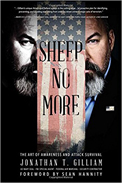
 |
Sheep No More: The Art of Awareness and Attack Survival
by Jonathan R. Gilliam
Post Hill Press
Former Navy SEAL and FBI Special Agent Jonathan T. Gilliam takes a decidedly philosophical approach to self-defense: Each of us are potential targets of crime and violence to various degrees depending on our experience, education, and exposure. Throughout the book, Gilliam reverses the perspective to that of the attacker—albeit military, criminal, mass murderer, or terrorist—so that we better understand how potential targets are formed and how we become the target.
Some of this is common sense, such as targets are selected to minimize the attacker’s exposure and maximize results. For example, military operations often strike before dawn in enemy strongholds, a mass murderer selects a crowded venue with weak security, and a criminal, if not emotionally driven, identifies a singular target in the most secluded area. All attackers do surveillance prior to striking, and they have a goal in mind. Even an emotionally driven attacker allows a few seconds to convince himself that he can hurt his target, identifying how and where he will strike.
Much of what an attacker does is size up potential vulnerabilities. He’s identifying a target and looking for a way in. All too often, we make ourselves vulnerable through ignorance and complacency. Sure, we might know of danger, but either don’t know where to look or even look at all. While the safest method is to flee from trouble, including the choice to avoid trouble areas in advance, this is not always a realistic approach in today’s world.
To better protect yourself, Gilliam suggests that you assess yourself as a target. Divide your life into sectors and then sub-sectors based on routine and activities. Within each sector are critical assets, critical areas, and critical times. Using comprehensive sector identification, critical areas of vulnerability will emerge along with potential avenues of approach for attackers. He finishes off this evaluation with a target equation that helps measure who, why, where, how, and when an attack will occur. If done thoroughly, it won’t just be one type of attacker identified. This analysis can be applied to every sector/locale within your life.
Knowing your areas of vulnerability will help you close avenues of approach, but you’ll never be able to eliminate them all. Eventually you’ll have to assume a defender’s mindset or what to do when an attack is underway. Here, pre-planning inspires a mindset that ultimately becomes instinctive, as opposed to making up a plan in the moment which is virtually useless.
Much of what Gilliam purports is developing the habit of situational awareness, especially in highly vulnerable areas such as moving freely through unfamiliar areas or pausing inside contained public areas, but even familiar situations and places become vulnerable based on the available avenues of approach and the time of day. For example, different types of home-related criminals strike the target at different times of day. Gilliam stresses a healthy dose of “what-if,” which inspires confidence and wards off fear.
The author uses many examples, both famous and personal to reinforce his dual-think approach (i.e. imagining the attacker and planning a defense against vulnerable targets). This method is at the core of his call for self-defense through awareness, which will help you evade an attack if you haven’t first avoided it through planning. As Gilliam says, freezing up or panicking during an attack, which is exactly what the overwhelming majority will do because they have no plan, may in fact seal your fate. At the very least, fear reduces your options and their effectiveness.
Gilliam’s overall approach to self-defense is built from years in the military and law enforcement and tempered by the reality of current events. His multifaceted experience brings unique insight, cutting past the charlatans. Most of us are never going to be Zen masters of self-defense, but we can increase our odds considerably by following Gilliam’s suggestions. He reminds us that as individuals we can keep walking about the planet either remaining paranoid of potential events (ignorance), naively hoping for the best outcome (complacency), or becoming educated about the sources and methods of potential attackers (awareness) and thereby increasing our odds of success and/or avoiding trouble altogether.
RECOMMENDED by the US Review
Next Focus Review
Previous Focus Review